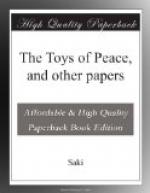Mrs. Steffink made a laughing protest, but gave a virtual consent by saying, “We must all wrap up well, then.” The idea seemed a scatterbrained one to her, and almost heathenish, but if afforded an opportunity for “throwing the young people together,” and as such she welcomed it. Mr. Horace Bordenby was a young man with quite substantial prospects, and he had danced with Beryl at a local subscription ball a sufficient number of times to warrant the authorised inquiry on the part of the neighbours whether “there was anything in it.” Though Mrs. Steffink would not have put it in so many words, she shared the idea of the Russian peasantry that on this night the beast might speak.
The cow-house stood at the junction of the garden with a small paddock, an isolated survival, in a suburban neighbourhood; of what had once been a small farm. Luke Steffink was complacently proud of his cow-house and his two cows; he felt that they gave him a stamp of solidity which no number of Wyandottes or Orpingtons could impart. They even seemed to link him in a sort of inconsequent way with those patriarchs who derived importance from their floating capital of flocks and herbs, he-asses and she-asses. It had been an anxious and momentous occasion when he had had to decide definitely between “the Byre” and “the Ranch” for the naming of his villa residence. A December midnight was hardly the moment he would have chosen for showing his farm-building to visitors, but since it was a fine night, and the young people were anxious for an excuse for a mild frolic, Luke consented to chaperon the expedition. The servants had long since gone to bed, so the house was left in charge of Bertie, who scornfully declined to stir out on the pretext of listening to bovine conversation.
“We must go quietly,” said Luke, as he headed the procession of giggling young folk, brought up in the rear by the shawled and hooded figure of Mrs. Steffink; “I’ve always laid stress on keeping this a quiet and orderly neighbourhood.”
It was a few minutes to midnight when the party reached the cow-house and made its way in by the light of Luke’s stable lantern. For a moment every one stood in silence, almost with a feeling of being in church.
“Daisy—the one lying down—is by a shorthorn bull out of a Guernsey cow,” announced Luke in a hushed voice, which was in keeping with the foregoing impression.
“Is she?” said Bordenby, rather as if he had expected her to be by Rembrandt.
“Myrtle is—”
Myrtle’s family history was cut short by a little scream from the women of the party.
The cow-house door had closed noiselessly behind them and the key had turned gratingly in the lock; then they heard Bertie’s voice pleasantly wishing them good-night and his footsteps retreating along the garden path.
Luke Steffink strode to the window; it was a small square opening of the old-fashioned sort, with iron bars let into the stonework.




